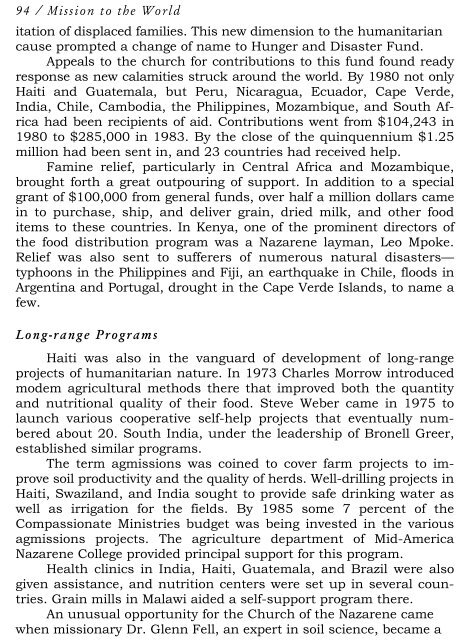The Nazarene World Mission Society
The Nazarene World Mission Society
The Nazarene World Mission Society
You also want an ePaper? Increase the reach of your titles
YUMPU automatically turns print PDFs into web optimized ePapers that Google loves.
94 / <strong>Mission</strong> to the <strong>World</strong>itation of displaced families. This new dimension to the humanitariancause prompted a change of name to Hunger and Disaster Fund.Appeals to the church for contributions to this fund found readyresponse as new calamities struck around the world. By 1980 not onlyHaiti and Guatemala, but Peru, Nicaragua, Ecuador, Cape Verde,India, Chile, Cambodia, the Philippines, Mozambique, and South Africahad been recipients of aid. Contributions went from $104,243 in1980 to $285,000 in 1983. By the close of the quinquennium $1.25million had been sent in, and 23 countries had received help.Famine relief, particularly in Central Africa and Mozambique,brought forth a great outpouring of support. In addition to a specialgrant of $100,000 from general funds, over half a million dollars camein to purchase, ship, and deliver grain, dried milk, and other fooditems to these countries. In Kenya, one of the prominent directors ofthe food distribution program was a <strong>Nazarene</strong> layman, Leo Mpoke.Relief was also sent to sufferers of numerous natural disasters—typhoons in the Philippines and Fiji, an earthquake in Chile, floods inArgentina and Portugal, drought in the Cape Verde Islands, to name afew.Long-range ProgramsHaiti was also in the vanguard of development of long-rangeprojects of humanitarian nature. In 1973 Charles Morrow introducedmodem agricultural methods there that improved both the quantityand nutritional quality of their food. Steve Weber came in 1975 tolaunch various cooperative self-help projects that eventually numberedabout 20. South India, under the leadership of Bronell Greer,established similar programs.<strong>The</strong> term agmissions was coined to cover farm projects to improvesoil productivity and the quality of herds. Well-drilling projects inHaiti, Swaziland, and India sought to provide safe drinking water aswell as irrigation for the fields. By 1985 some 7 percent of theCompassionate Ministries budget was being invested in the variousagmissions projects. <strong>The</strong> agriculture department of Mid-America<strong>Nazarene</strong> College provided principal support for this program.Health clinics in India, Haiti, Guatemala, and Brazil were alsogiven assistance, and nutrition centers were set up in several countries.Grain mills in Malawi aided a self-support program there.An unusual opportunity for the Church of the <strong>Nazarene</strong> camewhen missionary Dr. Glenn Fell, an expert in soil science, became a
















